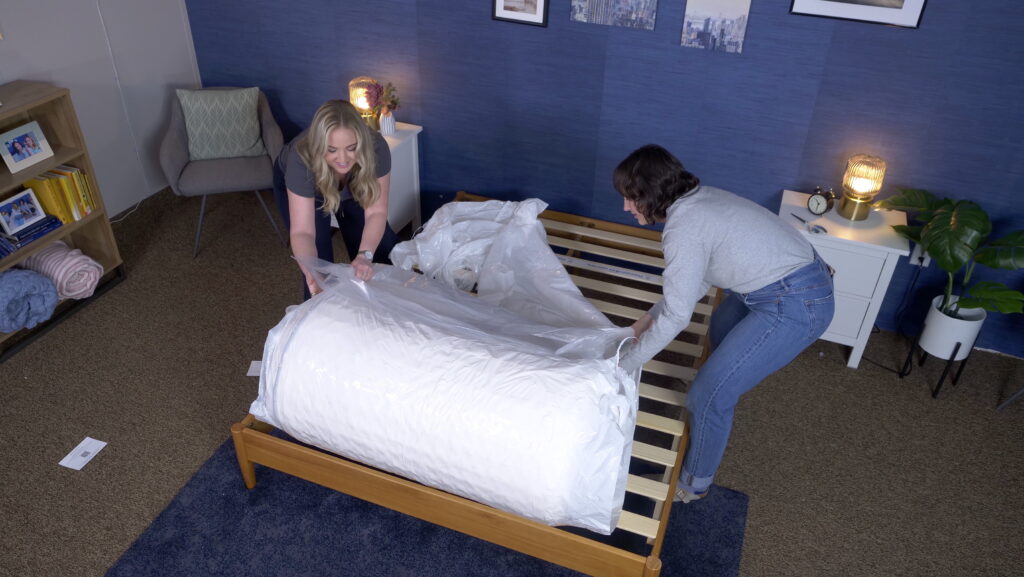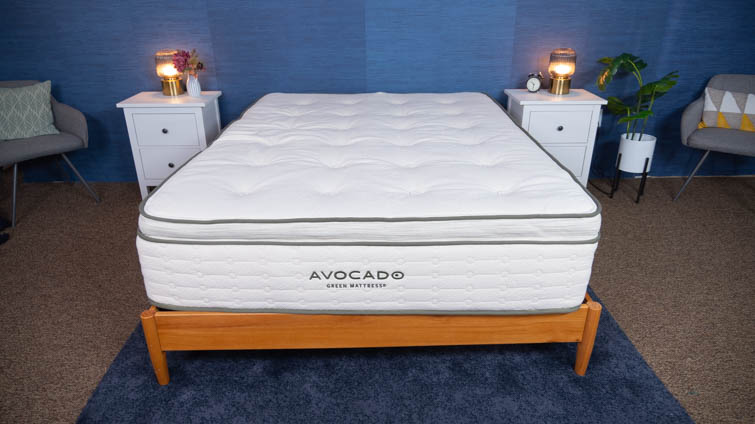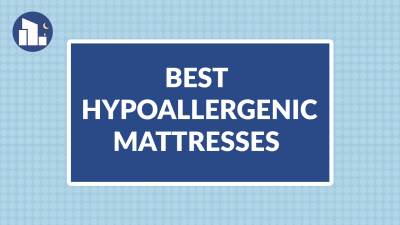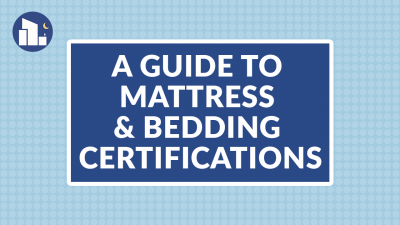Our team at Sleepopolis sleeps better at night when we’re confident in the materials that we’re resting on. However, not all mattresses provide the same high-quality ratings for comfort, durability— and most importantly—safety.
If you notice a pungent chemical-like smell when you air out a new mattress, chances are it is made of synthetic foams. The best solution is to learn how to get rid of them. That’s why we wrote this guide. We want to help you discover how long you should air out brand-new mattress. We’ll even include some tips on how to speed up a mattress off-gassing, helping ensure a slumber that’s safe and sound.
Subscribe to our Youtube Channel to watch out for new product reviews and guides in video format or follow us on Instagram.
What Is Off-Gassing?
If you’ve ever opened a product of any kind and immediately caught a whiff of a new smell, you’ve likely already experienced off-gassing. Essentially, off-gassing is the emission of a chemical gas, most often resulting from brand-new products that have yet to be aired out.
Some products are more likely to off-gas than others. For example, synthetically manufactured products tend to have a stronger or longer off-gassing period. Here are some common examples of everyday products that typically emit off-gassing, especially when first opened:
- Laser printers
- Non-stick pans
- Dryer sheets
- Cleaning products
- Furniture
- Paints
- Cars (your classic “new car smell”)
What Is Mattress Off-Gassing?
In the case of mattresses, off-gassing is extremely common. We see this most often in mattresses containing foam, as these sometimes have Volatile Organic Compounds (VOCs). These VOCs are often used to create fire retardant products, but they’re accompanied with a distinct chemical smell. When you open up a new mattress or release a bed-in-a-box from its vacuum-sealed bag, the fumes are a result of these trapped VOCs being released into the air in a vapor form.
Many different types of mattresses are susceptible to off-gassing, including:
- Memory foam mattresses, but especially those with cheap materials or polyurethane (poly) foam.
- Hybrid mattresses, which use sturdy coils at its base but still have foams in the comfort layers that may cause off-gassing.
- Latex mattresses, specifically those with synthetic latex, are prone to off-gassing.

Is Off-Gassing Harmful?
For the most part, most off-gassing isn’t harmful and shouldn’t cause long-term harm. However, if you’re an at-risk population (an infant, someone with respiratory issues, and those otherwise sensitive to scents), the likelihood of being negatively affected by off-gassing increases.
Low-quality foam mattresses made of polyurethane foam may emit VOCs. According to the Environmental Protection Agency (EPA), those chemical-like fumes can trigger allergic reactions and other health issues if you are exposed to it for an extended period. That’s why it’s important to purchase an organic mattress, or perhaps a quality mattress with a short off-gassing period.
Again, while this off-gassing period is normal and for the most part harmless in the mattress industry, here are some symptoms of off-gassing sickness you might want to watch out for:
- Morning headaches
- Frequent nausea
- Respiratory issues (usually triggers those with asthma)
- Allergic reactions (eye, nose, and throat irritation)
- Dizziness
How Long to Air out a New Mattress?
When you air out a new mattress, it usually takes around three to seven days to get rid of the pungent chemical smell. But that’s just to be safe; there are a number of brands with mattresses that complete the off-gassing process in a day or two.
While allowing a mattress to off-gas, you must do so in an open space or well-ventilated room so that the VOCs will not be contained in one area. However, if the smell still lingers after weeks or months, chances are the mattress can bring you more harm than good.
How to Speed Up a Mattress Off-Gassing?
When you receive your order, you might find the company includes a list of how to speed up a mattress off-gassing. Some mattress manufacturers include this guideline to ensure that you can enjoy your new bed as soon as possible. However, if you’re in a rush to sleep on your new bed, here are some ways you can speed up the off-gassing process.
Remove the Plastic Wrap
Even if the mattress you just bought will not be used at the moment, we recommend removing the mattress from its packaging as soon as possible. This allows the trapped fumes to dissipate sooner and faster.
Air Out Your Mattress Properly
A crucial part about airing your mattress is making sure you’re doing so in an open space. The off-gassing fumes will be able to dissipate more quickly this way. It is recommended to air out a memory foam mattress in a well-ventilated area or open garage. If it’s nice outside and your mattress is protected from the elements, it’s possible to lay the bed on a tarp and let it breathe outdoors as well.
Increase Air Circulation
Not all of us have a garage or a good open space. If this is the case, open your windows and doors to increase the air circulation. You can use fans to cross-ventilate and speed up the off-gassing process.
Use Baking Soda
You can sprinkle baking soda on the bedding to absorb and neutralize the chemical odor. After leaving it for about a day, you can easily clean it up using a vacuum cleaner.
What Are the Safest Mattresses?
There are air-quality friendly mattresses out there that don’t emit this harmful smell, so they can immediately be used in the first few hours of opening them. If this sounds like something worth shopping for, we recommend you take a look at the best organic mattresses.

Certifications to Look For
You can also keep an eye out for foams with the following certifications. Many mattresses on the market with the following certifications have earned them by having a lower amount of VOC emissions:
- CertiPUR-US certified foams don’t have harmful chemicals and also produce low VOC emissions (less than 0.5 parts per million).
- GOLS (Global Organic Latex Standard) certified latex pass rigorous tests and standards for materials and manufacturing.
- GOTS (Global Organic Textile Standard) certified textiles pass rigorous tests and standards for materials and manufacturing.
- Organic Exchange-certified ensures that a product went through organic manufacturing from start to finish.
- GreenGuard-certified means a mattress tested as one with low emissions.
- Oeko-Tex Standard 100-certified latex tested negative for harmful substances.
- USDA-Certified Organic applies to a mattress was safely overseen or approved of by a USDA authorized certifying agent.
- eco-INSTITUT certification ensures a mattress is without hazardous chemicals, VOCs, formaldehyde, and other harmful substances. These beds rarely have off-gassing.
FAQ
How dangerous is mattress off-gassing?
It may sound scary, but the amount of VOCs emitted in mattresses is not high enough to cause you extensive harm, especially if you let them dissipate immediately.
What are the chemicals to watch out for in mattresses?
What is off-gassing?
In the mattress world, off-gassing is known as the chemical-like odor that emits from brand-new mattresses. This is a common occurrence, especially with foam mattresses. It can take days for the smell to dissipate completely, but for the most part, it’s harmless.
Which mattress is safest?
We recommend purchasing an organic mattress or one that has professional certifications approving a low volatile organic compound (VOC) presence.
Conclusion
Even though off-gassing is an unavoidable task that comes with buying a new mattress, be sure to do the tips and recommendations we shared above. Make sure that you can have your good night’s sleep without the weight of thinking whether your bed can be dangerous for you.
Sources
Volatile Organic Compounds’ Impact on Indoor Air Quality. https://www.epa.gov/indoor-air-quality-iaq/volatile-organic-compounds-impact-indoor-air-quality. Last updated August 26, 2022.



